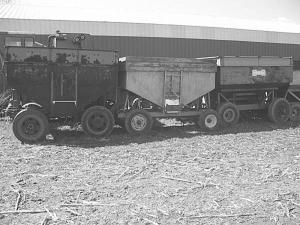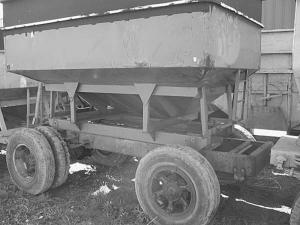2005 - Volume #29, Issue #4, Page #34
[ Sample Stories From This Issue | List of All Stories In This Issue | Print this story
| Read this issue]
He Uses Pickups To Make His Own Grain Wagons
 |
 |
FARM SHOW previously featured a story on how Stadler used the frame, wheels and axles off a 1978 Ford F-350 pickup to provide the running gear for a 175-bu. gravity wagon (Vol. 26, No. 2). Since then he has built several other wagons and, along the way, perfected his techniques.
"It's a relatively cheap way to come up with gravity wagons," says Stadler. "You can buy decent used gravity wagons at auctions for $1,000 to $1,500. Over the years I've used this idea to build a total of seven different wagons."
Several of Stadler's wagons are built from 1 to 2 1/2-ton Ford pickups. With some models the front axle has to be moved backward, or the frame cut in half and re-halved by sliding it forward and welding it together. "You need to have a strong pull point and the ability to connect the steering linkage to the existing tie rods. Even old combine axles will work," says Stadler. "The bottom line is that pickup and truck axles cost a lot less than commercial wagon running gears."
To build a wagon out of an F-350, for example, Stadler first strips everything off the pickup except the frame, wheels and axles. He leaves the front axle intact but moves the pickup's rear axle ahead 4 ft., then welds it solid to the frame and also welds steel reinforcing onto parts of the pickup frame to take some of the load off the axles. He removes the pickup's front springs and reinforces the front axle as well. He uses 2-in. tubing to make a tongue and connects it to the front axle via a clevis-type hitch. The wagon still uses the pickup's original tie rods for steering. The tie rods are tied into the tongue with 3/8 and 7/8-in. bolts. He welded in a pair of homemade, L-shaped steel cradles that support the sides of the wagon. A hitch welded onto the back end of the running gear allows him to pull another wagon behind.
According to Stadler, it's important to gusset the weld braces in order to help take the load off the front wheel axles. "Some front ends weren't made to carry real heavy loads. Two ton and heavier models may not have to be reinforced as the axles are already heavy enough," he notes.
Stadler says 2-ton truck axles work great with this idea because they're built heavier, have straight frames, and are easier to weld on.
Contact: FARM SHOW Followup, Ron Stadler, 7400 N. Custer, Monroe, Mich. 48162 (ph 734 587-3458).

Click here to download page story appeared in.

Click here to read entire issue
To read the rest of this story, download this issue below or click here to register with your account number.




